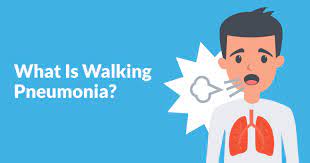"Walking Pneumonia Cases Surge in Canada: Causes, Symptoms, and Essential Care Tips to Protect Your Health"
Walking pneumonia cases are on the rise in Canada, particularly among children and young adults. Caused primarily by Mycoplasma pneumoniae, this mild but contagious respiratory illness spreads through airborne droplets. Symptoms include persistent cough, mild fever, and fatigue, often lasting several weeks. While typically manageable with antibiotics and home care, prevention measures like hand hygiene and mask-wearing in crowded places are crucial to curb transmission, especially in schools and healthcare settings. Learn about its causes, impact, and essential care tips to stay protected.


Overview and Rising Cases in Canada
Recently, Canada has seen an uptick in walking pneumonia cases, particularly affecting children and young adults. Walking pneumonia, also known as atypical pneumonia, is often mild and caused mainly by the bacterium Mycoplasma pneumonia. This bacterium spreads through respiratory droplets when infected individuals cough or sneeze, making it highly contagious, especially in crowded environments like schools and nursing homes.
Causes and Spread
The bacterium Mycoplasma pneumoniae is a primary cause of walking pneumonia, although viral and fungal pathogens can also contribute. Once inhaled, M. pneumoniae affects the respiratory tract, leading to symptoms that resemble a cold or mild flu. The incubation period, typically 1-4 weeks, can contribute to the spread as infected individuals may remain asymptomatic but contagious during this time. Factors such as weakened immunity and close contact with infected individuals can further increase susceptibility.
Who Is Most Affected?
Walking pneumonia affects all age groups but is especially common among children and young adults. Those at increased risk include people with chronic respiratory issues, such as asthma or chronic obstructive pulmonary disease (COPD), individuals with weakened immune systems, the elderly, and young children under 5. Additionally, people in crowded places—such as students, healthcare workers, and nursing home residents—face a higher likelihood of infection.
Symptoms
Walking pneumonia often begins with subtle symptoms that gradually intensify, lasting up to six weeks. Key symptoms include a persistent, dry cough, mild fever, sore throat, chest discomfort, fatigue, and headaches. In children, walking pneumonia can present with symptoms like wheezing, vomiting, or diarrhea. Generally, the illness is less severe than typical pneumonia, which is why many people continue their regular activities, hence the term “walking” pneumonia.
Diagnosis
Walking pneumonia diagnosis involves physical examinations and may include tests like chest X-rays and nasal or throat swabs to confirm the presence of M. pneumonia. Blood tests are occasionally performed to identify inflammatory markers or other signs of infection. Although mild cases may not require extensive testing, healthcare providers recommend diagnostic tests for those experiencing prolonged or severe symptoms to determine the need for antibiotic treatment.
Treatment
Treatment for walking pneumonia varies based on its cause. In bacterial cases caused by M. pneumonia, antibiotics such as macrolides (e.g., azithromycin) are commonly prescribed. Other antibiotics, including fluoroquinolones or tetracyclines, may also be effective, particularly for adults and older children. Viral infections causing walking pneumonia require supportive care rather than antibiotics, as antibiotics do not combat viruses. Over-the-counter medications can help alleviate symptoms such as congestion, cough, and fever. Healthcare providers recommend completing the full course of prescribed antibiotics to avoid recurrence or complications.
In more severe cases, especially among high-risk groups, treatment may involve hospitalization. Patients with underlying health conditions, like asthma, should consult with a healthcare provider early to manage symptoms and reduce the risk of complications.
Care and Recovery
Recovery from walking pneumonia typically takes four to six weeks, and during this period, supportive care is essential. Recommendations include adequate rest, hydration, and humidified air to ease breathing. Avoiding smoke or pollution is also crucial, as it can worsen symptoms. Over-the-counter medications may help reduce fever and alleviate nasal congestion, while warm fluids and steam inhalation can provide relief from cough. For most individuals, symptoms resolve without hospitalization, but those with respiratory distress or persistent symptoms should seek medical attention promptly.
Prevention
Walking pneumonia prevention hinges on good hygiene and respiratory health. Regular hand washing, covering coughs and sneezes, and avoiding close contact with sick individuals are essential preventive measures. Because walking pneumonia lacks a vaccine, other respiratory illness precautions, such as the annual flu vaccine, can help reduce the likelihood of secondary infections like influenza that can exacerbate pneumonia symptoms. Wearing masks in high-risk areas or during outbreaks, especially for people with chronic respiratory conditions, is also advisable.
As Canada experiences increased cases of walking pneumonia, public health authorities encourage awareness and adherence to preventive practices. Early detection and appropriate care can greatly reduce the spread and severity of walking pneumonia, especially in vulnerable communities.
